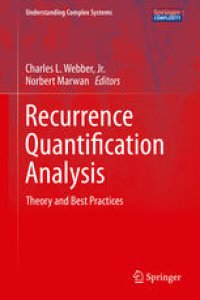
Ebook: Recurrence Quantification Analysis: Theory and Best Practices
- Tags: Nonlinear Dynamics, Systems Theory Control, Vibration Dynamical Systems Control, Biophysics and Biological Physics, Complexity, Earth System Sciences
- Series: Understanding Complex Systems
- Year: 2015
- Publisher: Springer International Publishing
- Edition: 1
- Language: English
- pdf
The analysis of recurrences in dynamical systems by using recurrence plots and their quantification is still an emerging field. Over the past decades recurrence plots have proven to be valuable data visualization and analysis tools in the theoretical study of complex, time-varying dynamical systems as well as in various applications in biology, neuroscience, kinesiology, psychology, physiology, engineering, physics, geosciences, linguistics, finance, economics, and other disciplines.
This multi-authored book intends to comprehensively introduce and showcase recent advances as well as established best practices concerning both theoretical and practical aspects of recurrence plot based analysis. Edited and authored by leading researcher in the field, the various chapters address an interdisciplinary readership, ranging from theoretical physicists to application-oriented scientists in all data-providing disciplines.
The analysis of recurrences in dynamical systems by using recurrence plots and their quantification is still an emerging field. Over the past decades recurrence plots have proven to be valuable data visualization and analysis tools in the theoretical study of complex, time-varying dynamical systems as well as in various applications in biology, neuroscience, kinesiology, psychology, physiology, engineering, physics, geosciences, linguistics, finance, economics, and other disciplines.
This multi-authored book intends to comprehensively introduce and showcase recent advances as well as established best practices concerning both theoretical and practical aspects of recurrence plot based analysis. Edited and authored by leading researcher in the field, the various chapters address an interdisciplinary readership, ranging from theoretical physicists to application-oriented scientists in all data-providing disciplines.